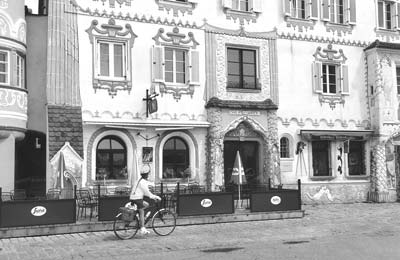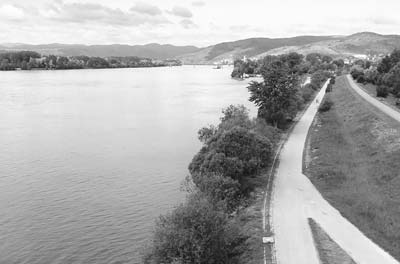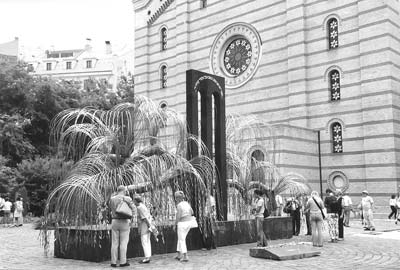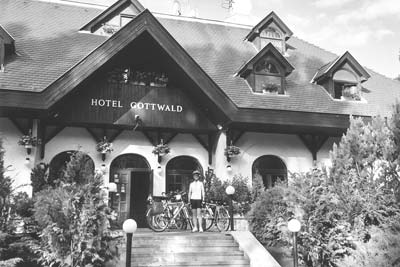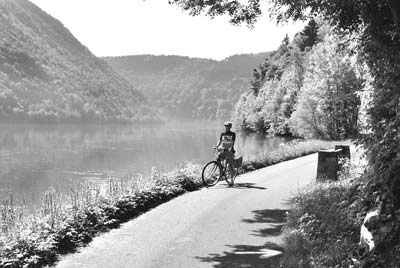Down the Danube — cycling from Germany to Hungary
by Fred and Ann Abeles, Frederick, MD
Reading about someone’s adventures always makes us want to follow in their footsteps. In this case, we were inspired to follow in Thomas Stevens’ bicycle tracks after reading his recently republished “Around the World on a Bicycle” (2001, Stackpole Books; available through Amazon.com).
In 1884, Thomas Stevens left San Francisco on a Columbia high-wheeler with the goal of traveling around the world. His diary gives a fascinating picture of the world at that time and of Stevens’ fortitude. We wanted to duplicate a small bit of his adventure by traveling on modern bicycles along the Danube, from Germany to Budapest.
Researching the trip
A search on the Web for bicycle trips along the Danube turned up Adventures on Skis/Adventure Sport Holidays, which offered package tours from Passau, Germany, to Budapest, Hungary. They made arrangements for us to fly on May 15, ’03, to Munich and continue by train to Passau. There, a representative of Rad & Reisen met us with bicycles, panniers, maps and vouchers for lodging.
The company transferred our luggage to each day’s lodging, and our job each day was to pedal approximately 40 miles along the Danube cycle path and through small towns to the next scheduled hotel or guest house. We chose the class A option for lodging, which included breakfast, and made our own arrangements for lunch and dinner.
Getting started
Our trip started out with a bang as we sat on the ground at Washington Dulles International Airport in a terrific thunderstorm. In spite of leaving Dulles 1½ hours late, we made up some time and arrived in Frankfurt with just enough time to make the connecting flight to Munich. The baggage handlers for Lufthansa did a super job and got our luggage onto our flight, so we had no delays in Munich.
We took the S-Bahn to the main train station and caught the train to Passau. European train systems are easy to navigate and are efficient.
Our hotel, the Hotel Weisser Hase (Heiliggeistgasse 1; phone +49 85 192 110 or visit www.weisser-hase.de) was just a couple of blocks from the station in Passau. After checking in and having a short rest, we were ready for a leisurely stroll of the Old City. We had dinner in front of the old town hall along the Danube and watched the evening activity along the harbor.
The next morning we met the tour representative and he went over the details of the ride, first in German for several couples and then in English for the four Americans. Although we booked this tour as individuals, it is such a popular trip that there are cyclists starting off every day from Passau, either on their own or with bicycles and materials supplied by a tour organizer such as Rad & Reisen.
We all headed over to the garage and picked up our bicycles, 21-speed “hybrid” bikes with back racks, panniers and cycle computers. We were warned that the panniers were not waterproof, so we packed things we wanted for the day into plastic bags before putting them into the panniers.
The ride begins
Then we were off, following the bicycle lane along the cobblestone streets of Passau, over the bridge and down the paved trail along the north side of the Danube. We passed through several small towns and saw old castle ruins on the hillsides.
Near the big S curve on the Danube, we took a small ferry for bicycles and pedestrians across to Schloegen, a resort complex that was the stopping place on our first night. Still a little jet-lagged and needing some time to study the package of materials we had received during our morning briefing, we relaxed and had an early dinner.
The next morning we were nearly the first in the restaurant for breakfast. Soon we were again on our way, this time on the south bank, traveling along the misty Danube flanked by lushly forested hillsides.
This was our pattern for the next several days, as we went on to Linz, Grein, Emmersdorf, Krems and Vienna. We tried to be on our way by 8 a.m. We’d stop at a store in one of the little towns for cheese, fruit and fresh bread, have a picnic along the river, then arrive at our destination between 2 and 3.
After a shower and changing into street clothes, we’d explore the town or sit at a coffee shop and enjoy the scenery, especially the lovely town squares in the villages. The guidebook pointed out the many old churches and abbeys to visit along the Danube. We especially enjoyed seeing new birds and flowers and learning about the importance of the Danube for transportation.
Linz & Melk
In Linz we rode the adhesion railway, the steepest such railway in the world. It takes you to the top of a small mountain, Pöstlingberg, where you have a beautiful view of the city.
In Melk we biked up the steep hill to the huge Benedictine abbey, where we toured the buildings open to the public and appreciated the many informative legends in English. We had biked in cold rain all day and were happy to spend some time in the abbey, drying off.
Then we rode across the river to the small town of Emmersdorf, where we lodged at the hotel Zum schwarzen Bären (Marktplatz 7; phone +43 2752 71249 or e-mail zum.schwarzen.baeren@wvnet.at), the fanciest lodgings of our whole adventure. For unknown reasons, we rated a 2-bedroom suite, so we had lots of room to dry our rain gear. After spending some time in the hotel’s big hot tub, all our chills from the rainy day were soon gone.
History along the path
After Melk, we entered the region known as the Wachau, a major wine-producing valley along the river. Here, the ground is so productive that no space is wasted — grape vines were even planted in the walls. Some bicyclists with stronger constitutions than ours were able to do some wine and schnapps sampling along the way, but we waited till dinner to try the delicious wines of the region.
In many places, the Radweg (bicycle path) was the former Treppelweg, or what we would call a towpath. When the Romans first started moving up the Danube into Northern Europe, they used slaves to pull their boats upriver. As commerce along the river increased, large ships were pulled upriver by teams of horses, sometimes with 40 or 50 horses tethered together. The development of steam eventually replaced the horses.
At Spitz, shortly before we reached Krems, we headed into town to visit the shipping museum, which has excellent exhibits on the history of shipping on the Danube.
On to Vienna
The days flew by and soon we too were flying — down the path to Vienna. We had beautiful weather and a strong tailwind the day we biked 55 miles downhill to Vienna. As Americans, it seemed strange to bike into a major city. The bicycle path stays along the river and away from streets until it is in the center of town. Even in the middle of the city there were ramps and paths that led us to the bicycle/pedestrian lane on the bridges so we did not have to be in traffic.
We turned in our bicycles in Vienna and spent the next two days exploring this beautiful city. For us, the highlight was the Technisches Museum. There they had a special exhibit on the history of the bicycle. We saw the early experiments with high-wheeler bicycles, such as the one Thomas Stevens rode and pushed around the world, as well as all stages in the development of the modern bicycle, including experiments with different materials from wood to carbon fiber.
We also saw the Bruegels at the Art History Museum; the art collection at the Academy of Fine Arts; exhibits on the history of Vienna at the Historical Museum of the City of Vienna and on the Jewish history of Vienna at the Museum Judenplatz; Schönbrunn Castle, and the Treasury and museums in and around the Hofburg.
Back on the road
After two days of “extreme” museum touring, my husband, Fred, was overjoyed to get back on his bicycle and continue down the Danube trail.
We left town in a cloud of smoke. On Sundays, the Viennese like to light up the barbecues for picnics in the huge park along the Danube. Every space was taken as we headed south along the river. The grilling area was followed by a few kilometers of nude bathers, sunning themselves in the park along the trail. These diversions made biking challenging through this area.
Our last night in Austria was in Petronell-Carnuntum, the site of a second-to-fourth-century-A.D. Roman town. There are several large archaeological parks where visitors can get an idea of the settlement and activities as they were during Roman times. The site was chosen both for its position on the river and for the mineral baths that are still in use in the neighboring town of Bad Deutsch.
Leaving Austria
The next day we crossed into Slovakia and headed on toward Bratislava and then Mosonmagyarovar, Hungary. Fred’s enthusiasm for the trip was given a boost by the lovely roller bladers in front of him on the path in Slovakia. It was not difficult to communicate with people along the way, as many spoke German and quite a few also knew some English.
Our route in Hungary took us on to Gyor, Tata, Esztergom (“Rome on the Danube”) and Budapest. We followed the Danube path to Mosonmagyarovar and then were directed onto roads to Gyor, Tata and Esztergom.
We thought the traffic must have increased considerably since the guidebooks were published, and we feel a route through Slovakia would probably be better than taking the roads around Gyor. The traffic in some areas was not pleasant. However, our stays in the towns were lovely, as both Gyor and Tata have wonderful Old Town centers with sidewalk cafés and interesting shops.
Our route to Esztergom took us over a couple of big hills and then back to the Danube. Esztergom is an ancient royal town, the birthplace of Hungary’s first king, Stephen I, later canonized, and the site of the basilica founded by him in 1001.
Our hotel in Esztergom was just over the canal from the fortress and basilica, so after our showers we had a pleasant walk through the Old City and up to the church.
Reaching Budapest
Our last day of biking was again along the Danube, mostly on the cycle path. We had a chance to ride several small ferries back and forth over the river as the better path changed from side to side.
We also biked the length of Szentendre Island. This island, built up of sand and clay from the river, forms a natural filter for the water of the Danube. The water drawn from wells on this island is clean and supplies Budapest with fresh water. At the lower end of the island we took another ferry back to the left bank at the artists’ colony of Szentendre and then continued on the bike path into Budapest.
The last few miles in the city were on bike lanes that shared the streets with a lot of noisy traffic. We were happy to reach our hotel on the edge of the large Városliget city park. After turning in the bicycles, we were tired. We had traveled 50 miles that day, including some city street navigation that required our concentration.
Exploring the city
The next couple of days we spent enjoying the city and its museums. Although we had been warned about pickpockets, we found the city no more threatening than any large metropolitan area. As we moved about the city we saw a lot of reconstruction taking place. Since the fall of Communism, the city has been undergoing a rebirth and finally repairing damage from WWII and the 1956 revolution.
We spent time up on Castle Hill, the site of the original Buda, and visited several museums in Pest. We especially enjoyed the Museum of Applied Arts. We also visited the Jewish Museum and Dohany Synagogue in the old Jewish quarter. There is a memorial garden attached to the museum with a sculpted willow tree that stands as a memorial to the Jews of Budapest who were murdered there.
We had a good look at Budapest, riding the funicular up to Castle Hill and taking the metro, a bus and several streetcars. The metro stations were especially interesting, as each station was beautifully restored, with good exhibits of the history of the area explained in Hungarian, English and German.
Along with our new friends from Munich, we attended a folkloric concert with an amazing cimbalom player before saying farewell to many of our acquaintances from the trip and catching our flight back to the U.S.
We enjoyed our Danube adventure and would recommend it to anyone willing to travel by bicycle. We frequently thought about the descriptions from Thomas Stevens as he traveled through this region over a hundred years ago. Some of the sights would have looked familiar to him — and others would have left him amazed.
Arranging your cycling adventure
We booked our trip through Adventures on Skis/Adventure Sport Holidays (815 North Rd., Westfield, MA 01085; phone 800/628-9655 or visit www.advonskis.com).
Our costs for the two of us for 19 days, including round-trip air, train, insurance, bicycle rental, two extra nights’ lodging in Vienna and two extra nights in Budapest, was $5,110. We spent an additional $1,100 on meals, museums, concerts, trinkets and transportation around Vienna and Budapest.
Rad & Reisen (Vienna, Austria; visit www.eurocycle.at) supplied us with city maps and information as well as cycle maps from www.esterbauer.com, which publishes a large series of bicycling tour books. However, the only booklet in English was “Danube Bike Trail,” which covered the trail from Passau to Vienna.
For the second part of the trip, they supplied the “Donau-Radweg Teil 3: Slowakische und Ungarische Donau von Wien nach Budapest” in German. The company did give us a small English addendum with some explanations along with directions to our hotels. Another source of good information on cycle trips is www.mayq.com.
Many towns along the route have websites with information on lodgings. The booklet “Donauradweg von Passau bis Bratislava,” which lists many of these sites, can be obtained from the Austrian National Tourist Office; phone 212/944-6880 or visit www.austria-tourism.at. For more information, you can also visit www.danube.at and www.donautal.niederoesterreich.at.
If you travel off-season, you probably do not need to make lodging reservations ahead of time. However, the trail is popular and many places are fully booked during the summer and fall seasons.

